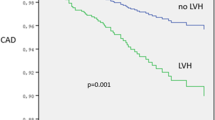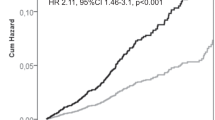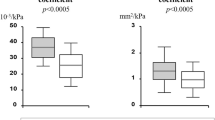Abstract
The impact of hypertension on left ventricular (LV) and vascular structure and the relation of left ventricular hypertrophy (LVH) with vascular changes in untreated essential hypertensives has not been fully explored. This study investigated the prevalence of structural abnormalities of LV and carotid arteries and their determinants in a large population of untreated, uncomplicated essential hypertensive patients. The Assessment of Prognostic Risk Observational Survey was a multicentre (44 centres) prospective study including 1142 untreated hypertensives classified as low or medium cardiovascular risk on the basis of the routine diagnostic work-up recommended by the 1999 World Health Organization/International Society of Hypertension guidelines. All patients underwent ultrasound examinations of the heart and carotid arteries. LVH and carotid structural changes were diagnosed when: (1) LV mass index exceeded 125 g/m2 in men and 110 g/m2 in women; (2) there was at least one plaque (focal thickening>1.3 mm) in any segment of either carotid artery or a diffuse common carotid intima–media thickness (IMT) (average of IMT⩾0.8 mm) was present. Overall, 1074 patients (504 women, mean age 48.1±11.4 years) completed the study with ultrasonographic examinations of good technical quality. The prevalences of LVH and LV concentric remodelling in the total population were 26.8 and 10.7%, respectively. Eccentric hypertrophy was more prevalent than concentric hypertrophy (15.2 vs 11.6%). One or more carotid plaques or thickening were present in 27.4% of the patients. A stepwise increase in IM thickness occurred from the lowest values in patients with normal cardiac mass and geometry (0.68 mm) to intermediate in those with LV remodelling (0.76 mm) and eccentric LVH (0.81 mm) and to the highest level in patients with concentric LVH (0.87 mm). Patients with LV concentric remodelling and concentric LVH had a significantly greater relative carotid wall thickness than those with normal geometry and eccentric LVH (0.25 and 0.26 vs 0.18 and 0.19, respectively, P<0.01). According to a multivariate analysis age, blood glucose, systolic BP and pulse pressure were the main independent predictors of LVH, while age, systolic BP and total cholesterol were the variables with the greatest impact on IM thickening. To conclude, this study shows that: (1) altered patterns of LV structure and geometry and carotid structural changes occur in a large fraction of patients with untreated essential hypertension; (2) there is a significant association between carotid wall thickening and LVH; (3) the probability of LVH or carotid thickening is significantly greater in elderly, in patients with higher systolic BP and in patients with associated metabolic risk factors.
This is a preview of subscription content, access via your institution
Access options
Subscribe to this journal
Receive 12 digital issues and online access to articles
$119.00 per year
only $9.92 per issue
Buy this article
- Purchase on Springer Link
- Instant access to full article PDF
Prices may be subject to local taxes which are calculated during checkout

Similar content being viewed by others
References
Cuspidi C et al. on behalf of the APROS Investigators. Role of echocardiography and carotid ultrasonography in stratifying risk in patients with essential hypertension: the Assessment of Prognostic Risk Observational Survey. J Hypertens 2002; 20: 1307–1314.
World Health Organization. International Society of Hypertension guidelines for the management of hypertension. J Hypertens 1999; 17: 151–183.
Koren MJ et al. Relation of left ventricular mass and geometry to morbidity and mortality in uncomplicated essential hypertension. Ann Intern Med 1991; 114: 345–352.
Levy D et al. Prognostic implications of echocardiographically determined left ventricular mass in the Framingham heart study. N Engl J Med 1990; 322: 1561–1566.
Bots ML et al. Common carotid intima and media thickness and risk factor of stroke and myocardial infarction: the Rotterdam Study. Circulation 1997; 96: 1432–1437.
O'Leary DH et al. for the Cardiovascular Health Collaborative Research Group. Carotid intima and media thickness as a risk factors for myocardial infarction and stroke in older subjects. N Engl J Med 1999; 340: 14–22.
Guidelines Committee. 2003 European Society of Hypertension—European Society of Cardiology guidelines for management of arterial hypertension. J Hypertens 2003; 21: 1011–1053.
Devereux RB, Reichek N . Echocardiographic determination of left ventricular mass in man. Anatomic validation of the method. Circulation 1977; 55: 613–618.
Ganau A et al. Patterns of left ventricular geometry and geometric remodelling in essential hypertension. J Am Coll Cardiol 1992; 19: 1550–1558.
Zanchetti A et al. Calcium antagonist lacidipine slows down progression of asymptomatic carotid atherosclerosis. Principal results of the European Lacidipine Study on Atherosclerosis (ELSA), a randomized, double-blind, long-term trial. Circulation 2002; 106: 2422–2427.
Hodis HN et al. The role of carotid intima–media thickness in predicting clinical coronary events. Ann Intern Med 1998; 128: 262–269.
Krumholz HM, Larsson M, Levy D . Prognosis of left ventricular geometric patterns in the Framingham Heart Study. J Am Coll Cardiol 1995; 25: 879–884.
Pick R, Jalil JE, Janicki JS, Weber KT . Myocardial fibrosis in nonhuman primate with pressure overload hypertrophy. Am J Pathol 1989; 135: 771–781.
Brilla CG et al. Remodelling of the right and left ventricle in experimental hypertension. Circ Res 1990; 67: 1355–1364.
Ravogli A et al. Early 24-hour blood pressure elevation in normotensive subjects with parental hypertension. Hypertension 1990; 16: 491–497.
Roman MJ et al. Parallel cardiac and vascular adaptation in hypertension. Circulation 1992; 86: 1909–1918.
Vaudo G et al. Arterial wall thickening at different sites and its association with left ventricular hypertrophy in newly diagnosed essential hypertension. Am J Hypertens 2000; 13: 324–331.
de Simone G et al. Relation of hemodynamics and risk factors to ventricular–vascular interactions in the elderly: the Cardiovascular Health Study. J Hypertens 2001; 19: 1893–1903.
Ohya Y et al. Hyperinsulinemia and left ventricular geometry in a work-site population in Japan. Hypertension 1996; 27: 729–734.
Zanchetti A et al. Risk factors associated with alterations in carotid intima–media thickness in hypertension: baseline data from the European Lacidipine Study on Atherosclerosis. J Hypertens 1998; 16: 949–961.
Sorlie PD et al. The relationship between lipids/lipoproteins and atherosclerosis in African Americans and whites the Atherosclerosis Risk in Communities Study. Ann Epidemiol 1999; 9: 149–158.
Mancia G et al. Prevalence of left ventricular hypertrophy in hypertensive patients without and with blood pressure control. Data from PAMELA population. Hypertension 2002; 39: 744–749.
Acknowledgements
The contribution of Dr Giuseppe Vargiu, of Sanofi-Synthelabo Italia, in conducting the study is gratefully acknowledged. The APROS study was supported by an unrestricted scientific grant from Sanofi-Synthelabo, Italia.
Author information
Authors and Affiliations
Consortia
Corresponding author
Appendix
Appendix
List of investigators
N Acquarone, G Lotti (Genova), G Benemio (Perugia), GB Ambrosio (Venezia), G Benemio (Città della Pieve), M Boscaro (Padova), G Calcagnini, R Manconi, P Pola, M Volpe (Roma), M Campanini (Novara), C Cappelletti (Firenze), A Cavatorta (Parma), L Chiandussi (Torino), A Circo (Catania), G D'Addetta (Cerignola), R De Cesaris (Foggia), E Degli Esposti (Ravenna), C De Matteis (Arienzo), A Ferrari (Seregno), R Giovannetti (Pescia), E Grasso, V Russo (Napoli), A Lechi (Verona), G Leonetti (Milano), G Maiorano (Bari), E Marchesi (Pavia), P Margaroli (Somma Lombardo), C Martines (Piove di Sacco), A Mezzetti (Chieti), L Mos (S Daniele del Friuli), R Nami (Siena), G Pascal (Suzzara), C Pasotti (Mede Lomellina), M Penzo (Vicenza), G Pinna (Asti), R Ragazzoni (Pesaro), A Rappelli (Ancona), A Santucci (L'Aquila), A Scala (Pozzuoli), A Stella (Monza), M Stornello (Siracusa), A Venco (Varese).
Rights and permissions
About this article
Cite this article
Cuspidi, C., Mancia, G., Ambrosioni, E. et al. Left ventricular and carotid structure in untreated, uncomplicated essential hypertension: results from the Assessment Prognostic Risk Observational Survey (APROS). J Hum Hypertens 18, 891–896 (2004). https://doi.org/10.1038/sj.jhh.1001759
Received:
Revised:
Accepted:
Published:
Issue Date:
DOI: https://doi.org/10.1038/sj.jhh.1001759
Keywords
This article is cited by
-
Impact of obstructive sleep apnea and hypertension on left ventricular hypertrophy in Japanese patients
Hypertension Research (2017)
-
Attitudes and preferences for the clinical management of hypertension and hypertension-related cardiac disease in general practice: results of the Italian Hypertension and Heart Survey
Journal of Human Hypertension (2015)
-
Attitudes and preferences for the clinical management of patients with hypertension and hypertension with chronic obstructive pulmonary disease in Italy: main results of a survey questionnaire
Internal and Emergency Medicine (2015)
-
Different pattern of carotid and myocardial changes according to left ventricular geometry in hypertensive patients
Journal of Human Hypertension (2013)
-
Intima-Media Thickness in Patients With Obstructive Sleep Apnea Without Comorbidities
Lung (2013)



